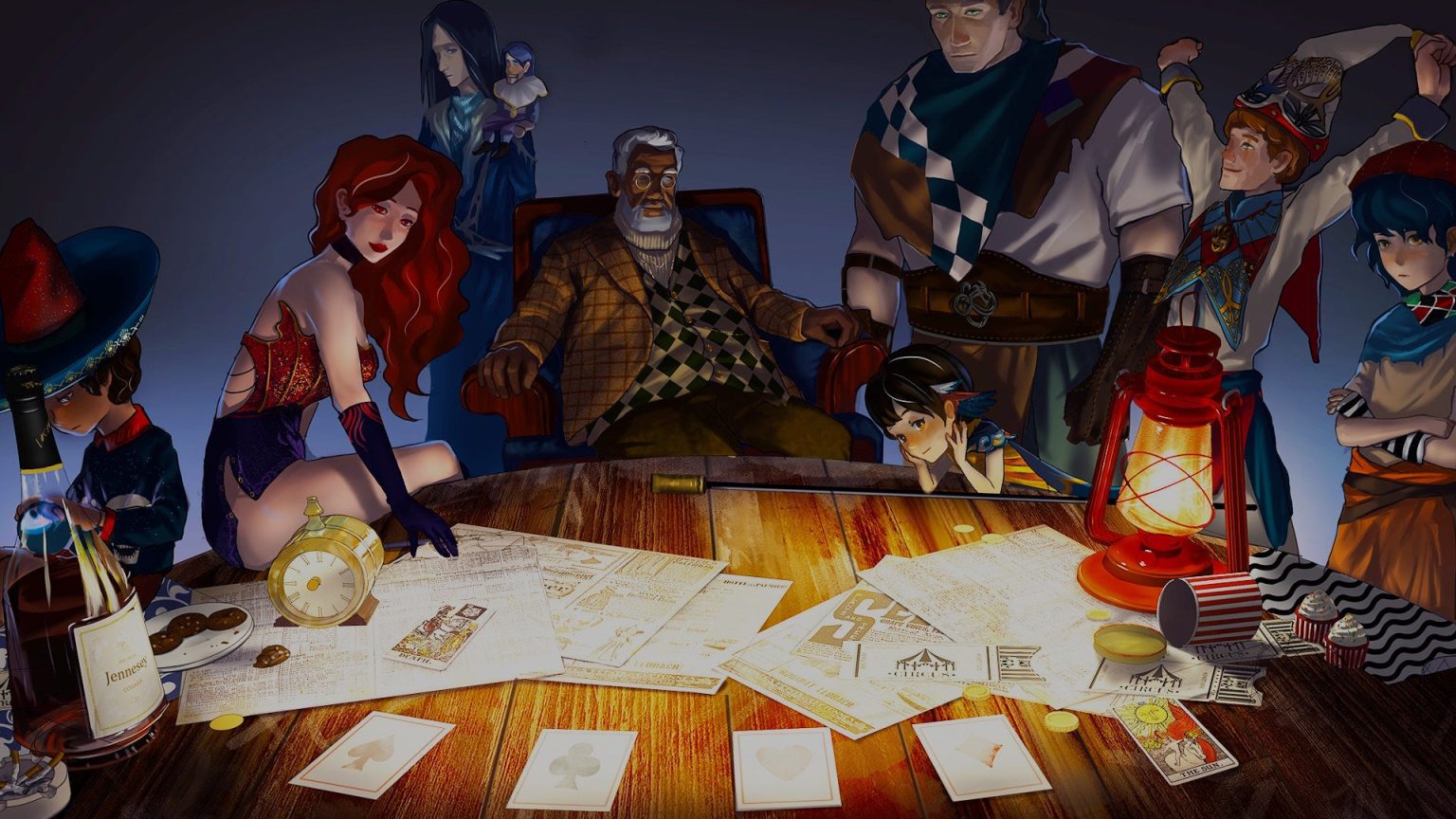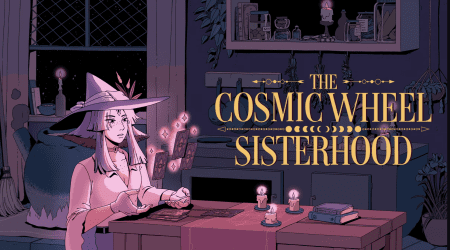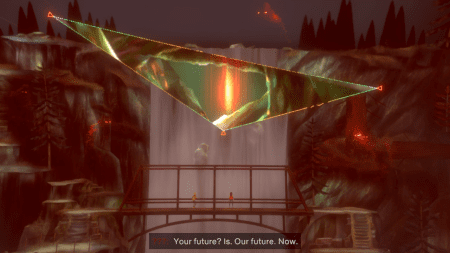I’ve been excited for months about Death Trick: Double Blind, out March 12 from a two-person team within Misty Mountain Studio. The new indie game is a visual novel that moves between two characters’ perspectives as players search for a missing star magician at a circus. While playing it hasn’t satisfied my investigative interests, Death Trick: Double Blind is a charming, absolutely beautiful visit to the circus.
The Greatest Show
Death Trick: Double Blind made headlines last fall when it was announced as part of the Nintendo Indie World Showcase. A murder mystery at a circus! A dazzling art style! The game’s press release promised delights that would astound:
In this nonlinear detective visual novel set in Morgan’s Traveling Circus, star magician Hattie has gone missing. An unlikely duo – one a fellow magician, the other a private eye with a bout of amnesia – investigate Hattie’s disappearance alternatively, each using their own perspective and information. With only a limited number of actions, they must carefully decide which leads to pursue, looking out for contradictions in the evidence. Sorting through clues and getting to know each whimsical character, they must crack the case by challenging anyone who seems deceitful.
Depending on which location you visit at which time as a certain character, you’ll happen upon different scenes and witness interesting interactions. The magician has more freedom to enter backstage areas; the detective can explore areas where the adoring public has gathered. The ticking clock drives the game forward, and the switching perspectives adds a layer of curiosity to the challenge. Who will I be able to find, I wondered, at the fairgrounds? Will I be able to get ahold of the mechanic by the lion enclosure? If they don’t answer the detective’s questions, maybe they’ll trust the magician?
The majority of the gameplay consists of talking, which could have been boring, if the suspects weren’t so damn endearing.

Characters Take Center Stage
The art in Death Trick, done by Jenny Yu, is the standout attraction. It’s a masterful balance of visuals. Each scene is a feast for the eyes, the renderings so strong that they occasionally stuttered on my Switch.
If the art is the attraction, the stars are the characters. Death Trick sports a beautifully rendered eight-person cast, with lively expressions and clever, subtle animations. Each person has a mesmerizing amount of detail. The love the creators have for their circus crew is palpable.
There are no animated cutscenes, but there are many unique “paintings” that can be discovered that add depth to the gameplay’s visuals. There’s also a secondary style of art in the form of black-and-white comic-book-inspired panels that illustrate actions from character testimonies or backstories. While it’s a clever strategy, it’s executed somewhat strangely—the secondary art style is much more cartoon-y than the game’s primary art. This dissonance generally wasn’t a problem, save for a particular crime scene “photo” that made it hard to take the victim’s appearance seriously.
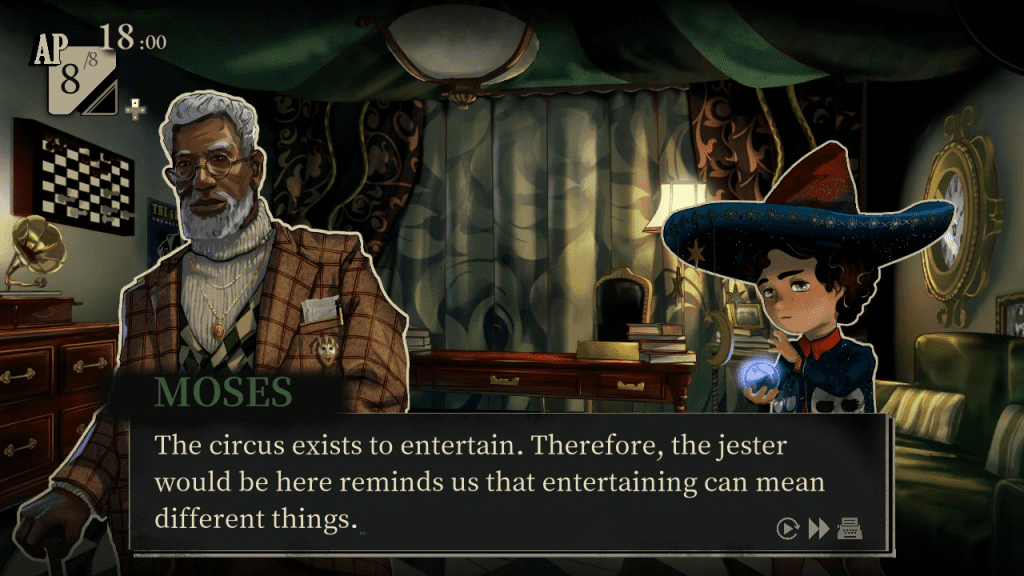
What is easy to take seriously are the characters themselves. The other half of the development duo, Mari Ma, writes characters with empathy. I was able to understand where each character was coming from—the things they loved, the things they hoped would happen. I found myself wishing that no one was “the bad guy.”
Sharp, thoughtful writing ensures everyone has something they’re worried about, a secret they’re holding. There’s the hardworking circus owner who is afraid to let his people down, especially after years of fighting bigotry. A bitter puppeteer who is protective over his craft becomes an early focus. I was genuinely attached to a duo of surrogate sisters—the fire dancer and the acrobat—and found myself spending more time with them than anyone else.
The characters, both in art and in writing, are the best part of the Death Trick: Double Blind. A great cast is a hallmark of the mystery genre.
Objection!
In the game’s credits, players are treated to a series of incredibly sweet gratitudes which include thank you notes to parents, friends’ cats, encouraging mentors, and games that have inspired the development team. The studio thanks the developers of the Ace Attorney series, Paradise Killer, Overboard!, Disco Elysium, VA-11 Hall-A, and Tangle Tower “for inspiring us to create this game.” Not only have I played all of those, but they’re some of my favorites too! This acknowledgement made me smile, as did the tongue-in-cheek reference one character made to another early in the game: “It’d be like having a lawyer named Mr. Wright.”
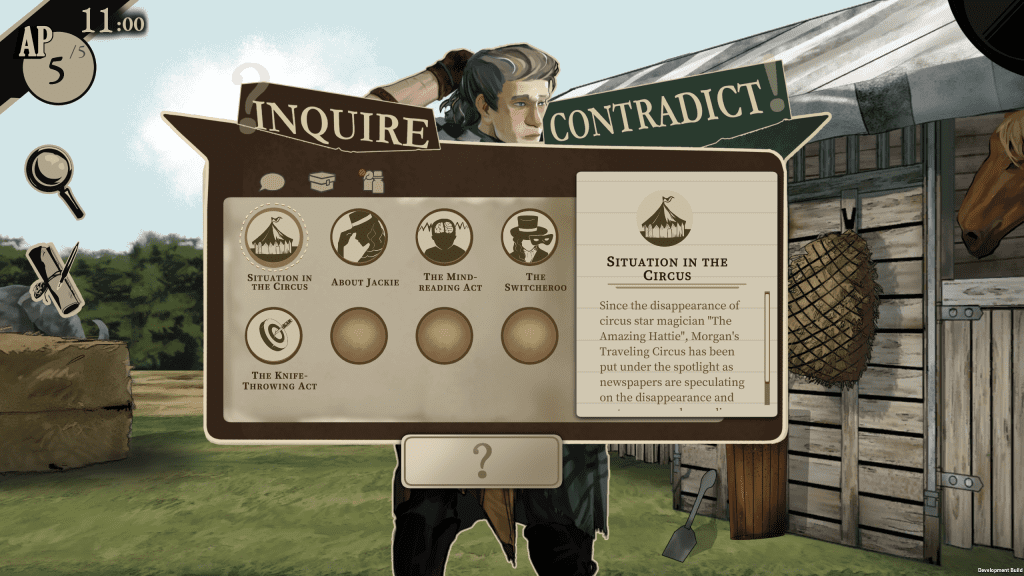
Similar to its influences, Death Trick tasks you with tracking down leads, finding clues, and questioning suspects. Players have access to three panels in their inventory: information, items, and profiles. Most of the game’s decision points stem from presenting the right information at the right time to the right person. The game is pretty forgiving, with multiple chances to present evidence, a generous auto-save, and characters telegraphing whether they want to talk about a lead (saving you from using one of your precious action points).
Unfortunately, the game never really lives up to its promise as a mystery game. There are some clever mechanics, such as presenting evidence and catching suspects in contradictions, but there’s also never quite enough to do with them. Investigating scenes usually yields nothing of interest, and while a lot of what I presented to characters was fun to hear their thoughts on, these moments very rarely revealed any useful clues.
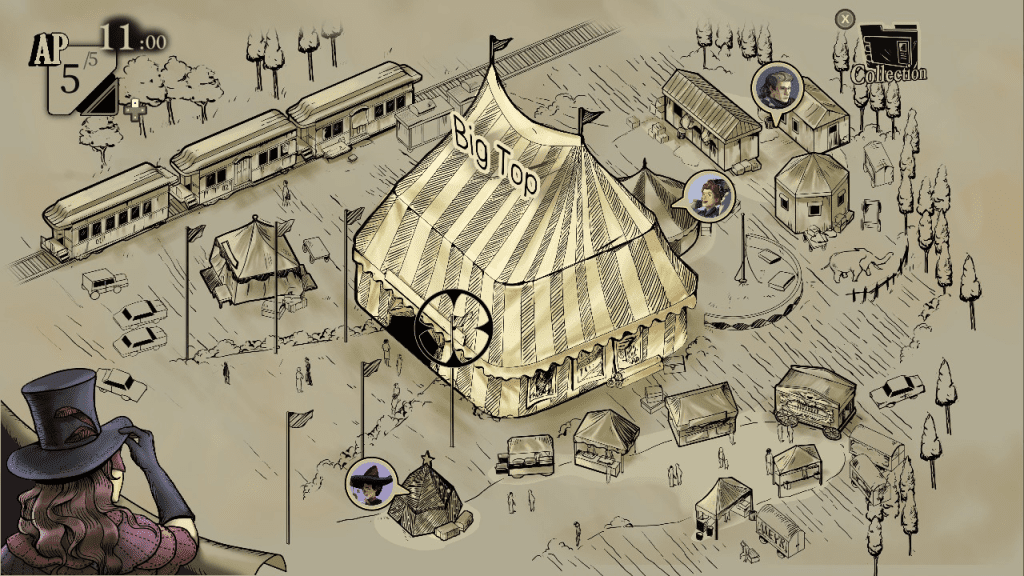
The character panel showcases nine characters, which, early on, made me feel excited and dazzled with the lack of knowledge I had. However, one of those is the victim, and another is the circus owner who hired you—and it’d be strange for him to invite a private investigator to a murder that he committed. All too soon, players will discover that another character, an eight-year-old fortune teller, won’t partake in any conversations but will allow you to exchange earned experience (by completing the game’s minimal quests) for additional action points. Going from nine suspects to six—quickly, at that—was disappointing.
Yet, in the (real life) last 30 minutes of the game, that classic mystery sensation comes back in full force. Death Trick’s finale is a series of logic deductions, all of which are excellent. Sadly, it comes at the very end of an already short experience (I finished Death Trick in about five hours). I wish we could have had more of this kind of sleuthing, and earlier.
Not Quite Right
The lack of intrigue isn’t my only grievance with the story. I frequently found myself pulled out of the experience with anachronistic dialogue. At one point, a character teases, “I was just f—ing with you.” Another character said something along the lines of, “I thought, like, what was the point?” The game is set in 1952, and the language often didn’t feel appropriate to the setting.
While the dialogue is all legible, it often doesn’t feel like it had a fine tooth comb. There are occasional typos. One character mentions that people aren’t attending circuses as much (true), and that they’re more entertained by radio and television. TV makes sense as a point of panic, but the radio has been around for decades prior.
Again, the characters and settings are so charming that I could often accept it, but it was definitely jarring. What was less tolerable was the number of times my game would bug out with the controls, rendering me unable to present evidence. The only way to fix it would be to completely close out the game and begin again. Luckily, the aforementioned auto-save feature kept me from losing progress, but I still had to restart my game at least half a dozen times during my playthrough, which got annoying quickly.
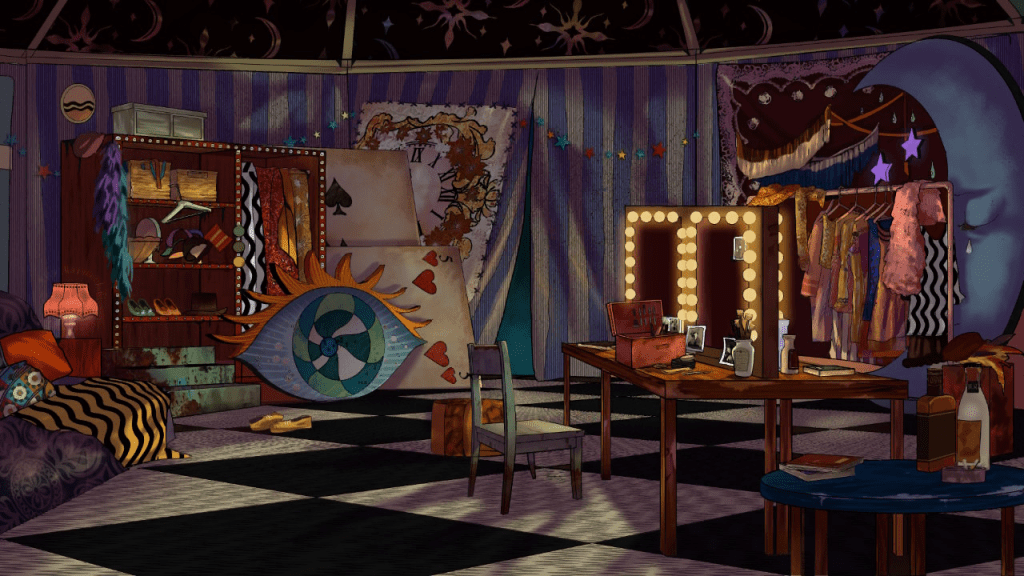
Besides glitches, there are also a couple of plot holes. The circus is currently in a rural town called Tugley, but Detective Jones is called all the way from San Francisco. Is he really the nearest private investigator? Is there a specific reason why he gets invited for this case? Additionally, there are many young male characters who appear to have been working in the circus for some time, but World War II is only briefly mentioned and there’s no mention of the mandatory American draft.
It’s a shame the game has so many little inconsistencies, as the production values and character work, again, are outstanding. Had the team taken more time to iron out typos and bugs, and perhaps explore a few other sleuthing scenarios, the experience could have been truly sensational.
New and Old Friends
As the train pulled away from the circus grounds with my new friends, I found myself sad that my journey with Morgan’s Traveling Circus was over. There’s only one ending of the game, and like I said, I enjoyed reading the wholesome credits.
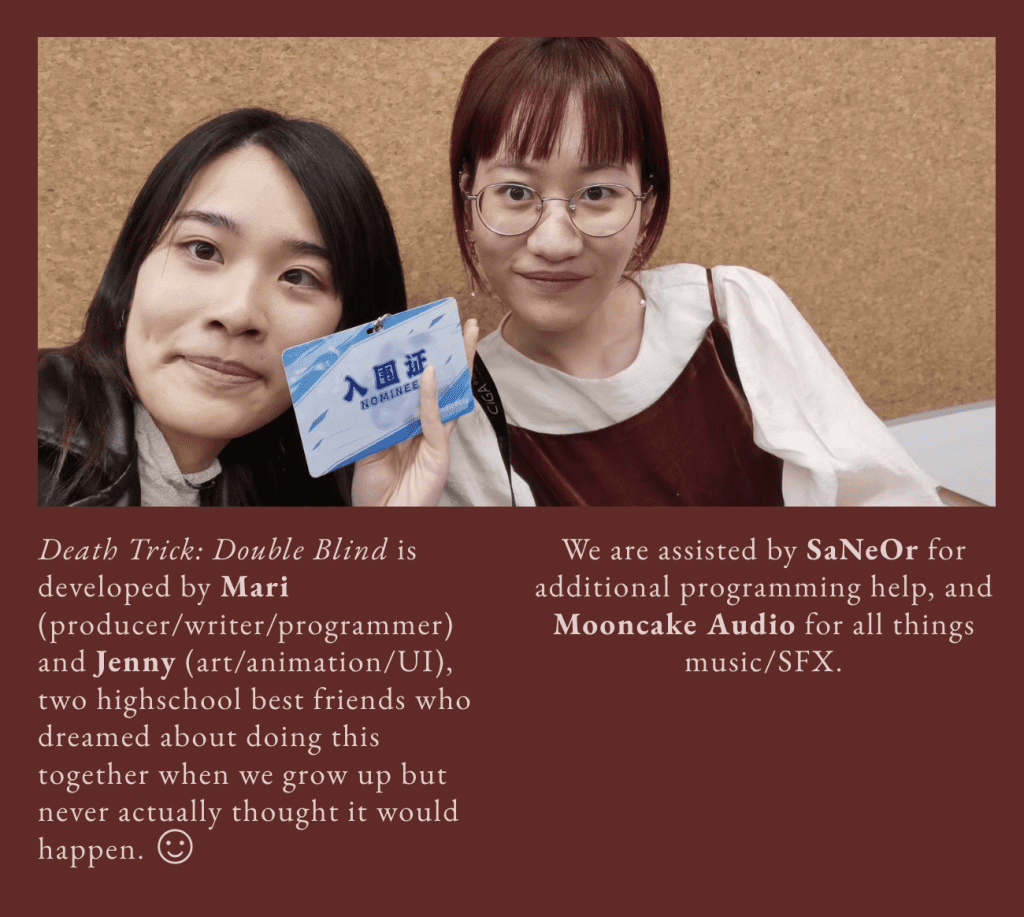
Two names are responsible for most of the work: Mari Ma and Jenny Yu. It’s a really impressive project from such a small team that’s already part of a small studio. Misty Mountain Studio, as far as I can tell, has only released one game: a well-reviewed 2021 Chinese mythology platformer, The Rewinder. The team writes in the credits, “Special thanks to Xinyu Wei, our boss, for greenlighting this project, and giving us your trust and full creative freedom.”
I’m happy for Ma and Yu; it’s exciting to see women making games. They shared on the Death Trick website that they’re high school friends. Reading their gratitudes, it truly felt like I was getting to know them as creators. And the feeling of kinship didn’t end there!
As the credits wound down, I was about ready to turn the game off when a Five Years Later… title appeared. Yes! I’m thrilled when I get to see a postscript to a story, and it felt like the sort of intentional follow-through I’d come to expect from Ma and Yu’s work.
Players can unlock different epilogues depending on how much time they spent with certain characters. When I only saw three epilogues, I was shocked. What had happened to the sisters? I hadn’t realized I hadn’t realized the game was tracking my level of engagement of how many “scenes” I had stumbled upon.
I enjoyed the epilogues I did get to see, and I think it’s clever to include a progression system of some kind, but I’m really not sure what else I could’ve seen to unlock the sisters’ epilogue. They were my most visited characters, by far. I might play the whole game over again to unlock the rest… but I also might not. There’s not enough actual replayability to keep me—and likely others—engaged for another playthrough. But, perhaps if I change my own mindset and think of it as catching up with old pals… then yes, of course, I always have time for my friends.

The Ones That Entertain, and the Ones That Observe
At a certain point, I realized Death Trick: Double Blind wasn’t going to be the engaging mystery I had hoped it would be. I guessed “the culprit” pretty early on. Sometimes I challenged suspects with what I thought would be a juicy bit of information, just to have them laugh or brush me off, and I felt disappointed by their lack of engagement.
Early on, the game explains that you can get assigned experience-earning quests. This excited me, thinking I was going to uncover a lot of circus secrets. However, after the first hour or two, the quests stalled out. Soon, I had more action points than I knew what to do with, and I often spent hours just chatting with my favorite characters about random stuff I had in my pocket.
As a player, I wanted to be a player. I wanted to be the one to solve things; I wanted to put two and two together. Both the magician and the detective often explain their thinking to other characters, making their deductions aloud. I wanted to be a part of that logical process, but instead, except for the very last part of the game, the investigations were told to me rather than with me.
When I started to accept that Death Trick: Double Blind was firmly a visual novel where I was an active reader, rather than a player of a mystery game, I was able to enjoy myself. I truly had to sit back, relax, and enjoy the show.

Final Thoughts: Step Right Up!
Death Trick: Double Blind, while imperfect, is colorful and engaging. Perhaps it’s just like a real day out at the circus—you see some cool tricks, but then you eat too many sweets and you get overwhelmed by the crowds. Yet, at the end of the night, you’re still delighted by what you’ve seen, and you know you’ll remember it.
Death Trick’s story embraces you, folds you in, just the way that the circus performers welcome Jackie the magician. It’s an enjoyable game for anyone who loves little worlds and characters. It’s not very challenging, which can be a pro or a con, depending on your expectations and desire.
I had a hard time thinking of how to score Death Trick: Double Blind. I enjoyed my time with the game but wanted more bite with the experience. I admire the efforts of those who made it, but I also felt the game was too ambitious and held back by its desire to meet those aspirations.
Death Trick: Double Blind won’t be a game everyone enjoys, but it certainly will have its audience. I imagine there will be a lot of fan art. I hope those people—romantics, thinkers, dreamers—find Death Trick: Double Blind and enjoy the ride.
Score: 8.0/10
Death Trick: Double Blind, developed by Misty Mountain Studio and published by Neon Doctrine and Another Indie, releases on March 12, 2024, for PC, Mac, and Nintendo Switch.
Disclaimer: A Switch review code was provided by the publisher.
Amanda Tien (she/her or they) loves video games where she can pet dogs, punch bad guys, make friends, and have a good cry. She started writing for the site in 2020, and became an editor in 2022. She enjoys writing about mystery games, indies, and strong femme protagonists.
Her work has also been published in Unwinnable Monthly (click here to read her cover feature on Nancy Drew games), Salt Hill Journal, Poets.org, Litro Magazine, Public Books, and more. She was the Co-Founder and Editor-in-Chief of Columbia University's Culinarian Magazine, and served for two years as the Managing Editor of Aster(ix) Literary Journal.
She recently graduated with a MFA (Master of Fine Arts) in Creative Writing from the University of Pittsburgh. Her writing, art, graphic design, and marketing work can be viewed at www.amandatien.com.
She does not post a lot on social, but you can find her on X and on Instagram.


